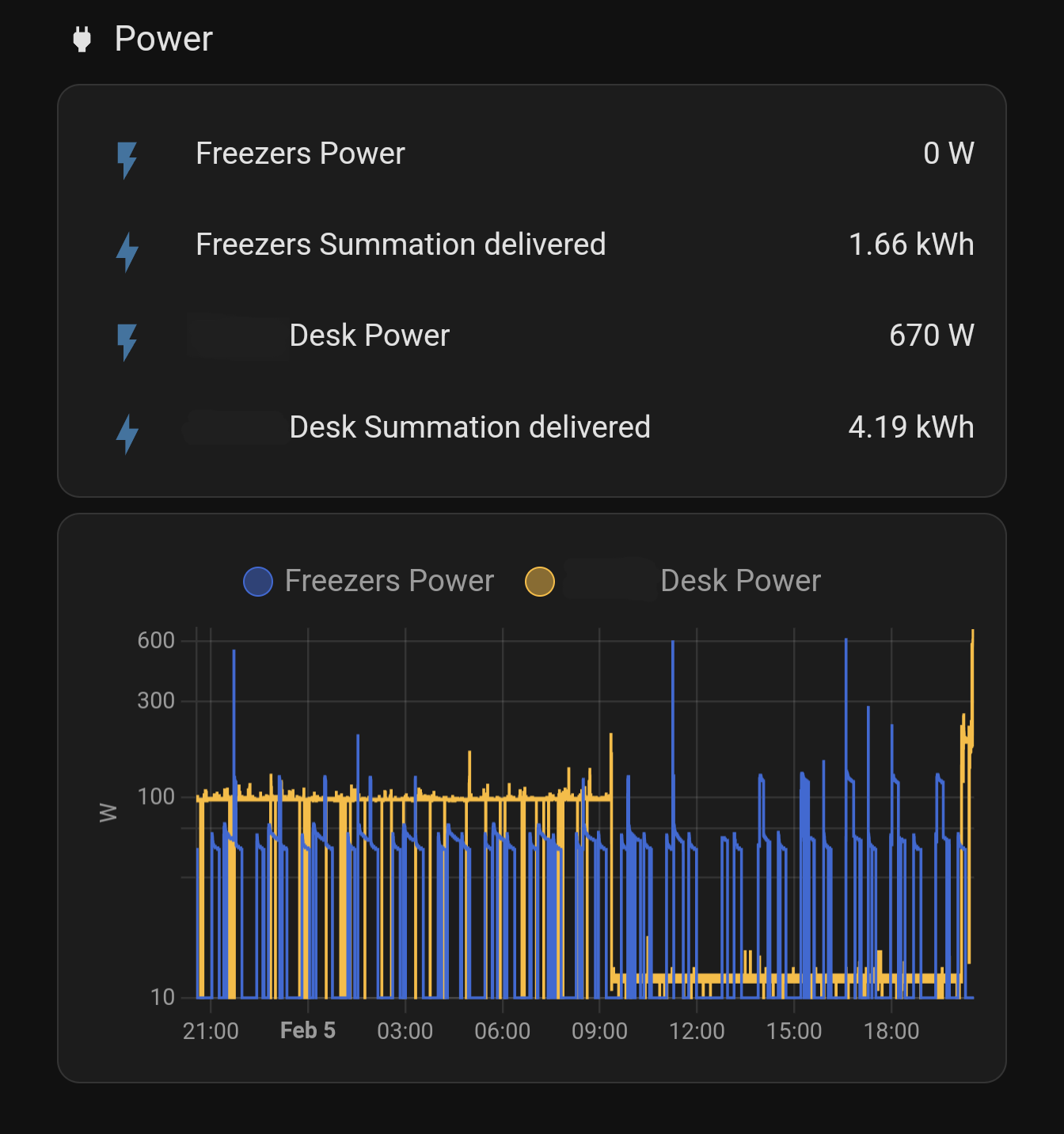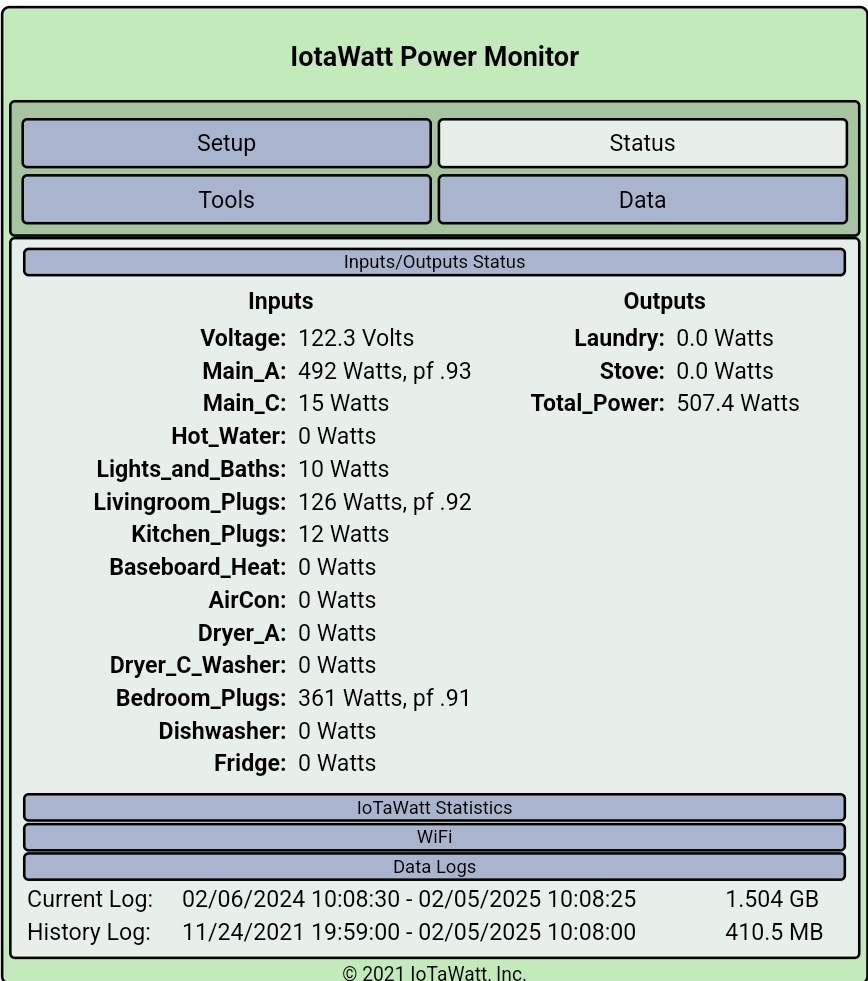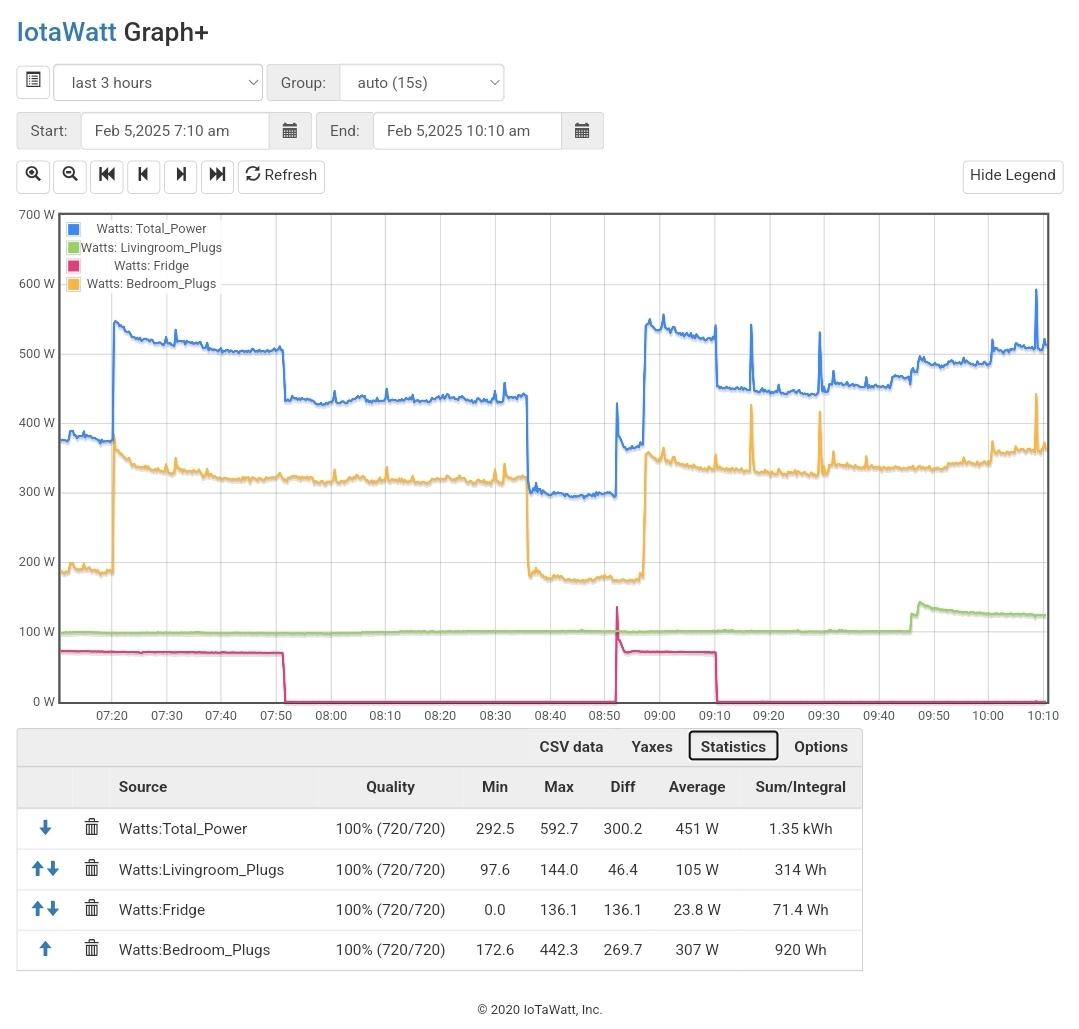I’m in the process of getting my Home Assistant environment up and running, and decided to run a test: it turns out that my gaming PC (custom 5800X3D/7900XTX build) uses more power just sitting idle, than both of my storage freezers combined.
Background: In addition to some other things, I bought two “Eightree” brand Zigbee-compatible plugs to see how they fare. One is monitoring the power usage of both freezers on a power strip (don’t worry, it’s a heavy duty strip meant for this), and the other is measuring the usage of my entire desktop setup (including monitors and the HA server itself, a Lenovo M710q).
After monitoring these for a couple days, I decided that I will shut off my PC unless I’m actively using it. It’s not a server, but it does have WOL capability, so if I absolutely need to get into it remotely, it won’t be an issue.
Pretty fascinating stuff, and now my wife is completely on board as well; she wants to put a plug on her iMac to see what it draws, as she uses it to hold her cross-stitch files and other things.
7 months later update:
I’ve expanded HA quite a bit and have a decent grasp on where my electricity is being used. Suspending my desktop has saved a shitload of power: under Linux, when suspended, it draws ~10W of power at any given time vs ~100W when idle. Also, I put smart plugs on the server cluster; the total usage of the entire cluster - 4 mini PCs, 1 SFF, and 5x HDDs (NAS) - over the last 7 months so far is currently at a whopping 465 kWh. That’s ~66 kWh a month. Barely 5% of my monthly electrical usage.
Have you considered putting your gaming pc in one of the storage freezers? /s
Perfect, I don’t need to run the fans anymore!
Seriously though - we have 5 kids, and feeding the little shits is expensive, so we freeze a lot of things for storage. I thought for certain the freezers would be power hogs compared to an idling PC, but I was very surprised to be proven wrong.
Next up… Measuring my server cluster 😬
Measuring my server cluster
Personally, I just don’t ask questions I don’t want the answer to.
I know they’re gonna be a power suck lol. Three mini PCs, a SFF PC, 4-bay hard drive docking station, 8-port switch, and a RPi0w… Hoping for a max of 200W, but I suppose we’ll see what happens 🫤
I see your 4-bay docking station and raise my 20-bay storage server. I even stopped counting how much the hardware costs for it :p
raise my 20-bay storage server.
I raise you my 72 bay monster… https://www.ebay.com/itm/126301431412
But I have 512 GB of ram in mine…
It’s attached via USB to a 2014-era Mac Mini running OMV; it’s a dedicated NAS and nothing else. Honestly not a huge fan of that hardware setup at this point, as the Proxmox cluster running all of my VMs and whatnot sees it drop out periodically for absolutely no reason. I’ve already tweaked the network adapter within the OS to stay powered on, because apparently Apple hardware has a mind of its own and just decides to shut various components off for “power saving” reasons.
The kicker is that I’m upgrading it to a 7th-gen based server soon. My dad gave me an old Pentium 4-powered HP Proliant DL110 last year, the case of which has 10x 3.5" drive bays, and is fully ATX compatible, so I’m gonna drop in a 7th gen mobo with Pentium G4560T (already have that on my desk), a newer PSU, and an HBA card. Don’t need a ton of processing power for a dedicated NAS running OMV - just a lot of expansion capacity.
You might need to lower your expectations
FYI - the cluster is pulling 115-140 watts.
- 1x Mac mini 2014, running OMV as a dedicated NAS (i5-4308U, 16GB RAM)
- 4-bay Sabrent DS-SC4B, attached to Mac mini (3x 4TB WD Reds in RAID5, 1x 4TB WD Black as hot spare)
- 1x 8TB WD backup drive (it’s something)
- 2x HP Elitedesk 800 G3 mini (or G4, don’t remember), both running Proxmox (i7-7700T, 32GB RAM each)
- 1x Dell Optiplex 7050 SFF running Proxmox (i7-7700, 32GB RAM)
All running multiple VMs (Docker and other) and LXC containers.
I’m impressed, honestly. I was expecting 200+ watts minimum. It’ll be interesting to see the spikes as it’s used over time. I am going to move the HA server (Lenovo M710q running HAOS on a Pentium G4560T & 4GB RAM) down to the cluster soon, as it’s sitting on my desk at the moment…
I’m surprised! Seems like it should be more, but I haven’t done any wattage calculations in a while, so maybe power efficiency really has gotten that much better.
Do you know if the drives were spun up or down at the time? I know idle vs. active makes a difference, but if they were spun down entirely, that’s kind of cheating.
I watched as everything booted, didn’t pull much more than 150 watts. But it’ll be interesting to see how it goes over time.
Lat I checked, it was 40w idle for me on the kill-o-watt. Spinny rust and all!
deleted by creator
deleted by creator
A fridge can create a fairly low overall temp, but with something like a PC generating a ton of heat inside, it can’t keep up. The fridge just can’t move the heat fast enough and becomes an insulated box trapping the heat instead.
Chest freezers are exceptionally energy efficient. It’s not a very good comparison.
Ah, but only one is a chest freezer 😉
That, and I used to have a freezer that was a power suck.
Yeah, man, getting into Home Assistant and messing with energy monitoring did more than thousands of chastising TV segments to get me to fully shut down my computers.
Who gives a crap about gaming use power consumption, give me idle benchmarks, you cowards. Do you even know how kWh work?
deleted by creator
How, if it’s not exposed to the internet? Burglars?
Is your gaming PC air gapped from the internet??
No. What kind of attack are you afraid of by idling a computer connected to your ISP router?
Any program on your PC that maintains or frequently initiates outbound connections, other machines on your LAN spreading an infection, literally any Trojan, etc. Double that if you haven’t disabled UPnP on your ISP router which is probably on by default.
If you are afraid of your PC infecting itself by background outbound connections, you should not turn it on at all. Running 24h vs 6h a day barely makes a difference in this regard - yes, there are fewer “random internet noise attacks” in less hours, but if your LAN is that dangerous, the computer should not be on for 5 minutes. Either you trust your LAN enough to have a computer running, or not.
Double that if you haven’t disabled UPnP on your ISP router which is probably on by default.
Talking about the sane defaults I mentioned earlier - my router has it off as a default. But if it wasn’t, my approach wouldn’t be to turn devices off¹ but change the router setting.
¹ I actually do turn off/plane mode all my non-server devices when I’m not using them but not for that reason.
You’re totally right, not turning it on at all would be safer. But we do need to use them so it makes sense to turn it on while in use. Security is only good up to the point of it making your machine unusable. Most of the attacks you see on running computers by happens overnight anyway, or otherwise when your machine is sitting idle not in use. Plus it gives you the opportunity to witness odd behavior if it were to happen while you’re using it.
And no, you should never trust your LAN in the year of our lord 2025. We are well beyond that in the cybersecurity landscape and have been for 10+ years. Zero Trust is the name of the game. If a device is on, and connected to the internet, it’s a target, as are any other devices on that network. Pretend that is not the case at
deleted by creator
Against random internet noise? Yes, absolutely
OK but what if you have a lava lamp that is synced to the moods of a sarcastic and greedy AI?
Security is about to get really weird. It used to be the Internet of Things we had to worry about, but now we have Things in Internet.
wtf is that 😄
But I agree, random hardware in your LAN is more of a security threat than anything coming from outside in many cases.
deleted by creator
Most ISP routers have sane default settings and block all incoming traffic, you don’t even reach their log in interface. If they are somewhat updated you’ll be fine in most cases.
Yeah. I got a pro managing it.
It has never occured to me my whole life to not suspend or shut down computers overnight. It wakes up in like 2 seconds why wouldnt you, even if it used only an extra 1W
You must be pretty young, because back in the dark days of spinning HDDs a computer would take 5+ minutes to boot.
Those days were at worst almost 10 years ago.
Stop living in the past with those situations.And you get an SSD.
And YOU get an SSD.
And you fine sir also get an SSD!Suspend != boot
Even in 2010 or earlier waking a pc from suspend would have only taken 2-3 seconds because the whole system state is in RAM not on disk.
At least until MS muddied the waters with “hibernate”.
The problem I have with this I put the PC to sleep overnight every night - and like clockwork, Windows wakes it back up sometime overnight to do… Something.
I’ve been diagnosing the issue for years - checking wake timers, switching hardware devices permissions to wake the system off. I might fix it for a few months and then a new Windows update comes along and it’s back to its usual routine of waking itself.
Looking forward to seeing if it persists with Linux when I move at the end of support period for Win10 later this year.
Looking forward to seeing if it persists with Linux
I have never had what you described happen in my past 15 years of using linux, i hope you find your way around things, linux is dope once you get used to it.
My PC goes down from 70W idle to 2W when suspended. I also have a master slave power strip, that turns of all my peripherals (speakers, lights, audio interface, etc) when the PC drops below 10W so that saves some extra energy.
Windows is gonna Windows. Even if you did track down the issue your one update from a borked system or square one when they alter the setting and relocate it on their own accord.
Yeah I use Linux for my servers and my HTPC, but I never really hibernate or sleep those so I had no idea if it might occur there too. It’s great to hear this is not likely to be an issue - thanks
Removed by mod
It has never occured to me my whole life to not suspend
Reliability issues with suspend-to-ram are rather common. Shutting down is an option, but session save and restore is a relatively recent thing and not supported by all desktop environments. I.e. it’s the post startup part that takes the longest.
TBH I didn’t think it used a whole lot at idle, what with modern manufacturing processes and all. I was fairly surprised.
Couple of thoughts:
-
That smart plug may not be rated to the max wattage when GPU and CPU are at full blast. Be careful, because that could be an expensive mistake. Place a surge protector between the smart plug and the PC to be safe. Also run the PC full tilt for a while and make sure the smart plug doesnt get warm. If it does, fores have been known to start from those.
-
Sounds like you know this with WoL, but suspend is your friend 😉 If the gaming PC is linux and you run into suspend issues, let me know, I’ve seen 'em all.
The plugs are rated for 1800W each. Should be fine. I hit 670W a bit earlier, running Furmark VK and Cinebench R23 multi-core simultaneously for shits and giggles.

Oh nice. Do you have a link to the plugs you chose? I got some 20amp ZigBees from Aliexpress for $3 each, work great, but I wouldn’t trust them to handle their rating.
Hah, Wyze use the same shell for their WiFi model: https://a.co/d/3kSQaoF
I think these are all based off these ZigBee models at $4 a pop: https://www.alibaba.com/product-detail/US-Smart-Home-Tuya-Alexa-Voice_1601241553658.html
Place a surge protector between the smart plug and the PC to be safe.
What benefit does this serve in this situation?
Fail safe. It’ll trip the power before it hits the wall and burns the house potentially limiting a fire or containing whatever did happen.
Ok, just be sure it has an integrated circuit breaker otherwise its just…a surge protector. You’ll also need to identify what load it triggers at. For example, I use these on my gear https://tripplite.eaton.com/isobar-4-outlet-surge-protector-6-ft-cord-3300-joules-diagnostic-leds~ISOBAR4ULTRA and they’re rated to 12A which should protect a 15A rated smart plug. I put rated in italics because errrryone is buying CE (instead of UL listed) smart plugs.
I’m not OP or the right person. Wrong recipient lol. But info was noted for my own use.
deleted by creator
Depends on the driver. Usually for finicky ones you can do an rmmod at suspend and a modprobe on resume. What distro, and are you using the default suspend mechanism?
deleted by creator
There are a couple of ways:
- Formally add a system entry to run at suspend/resume (like how nvidia does in their driver package)
Or
- Write a script that rmmods, suspends, sleeps, modprobes, and map it to Cntrl-Alt-Shift-S
I usually do 2 because I like the hotkey method for desktops, and it keeps things the same for both. Also allows me to close a lid on a laptop and leave it on. But 1 is more “formal”.
Happy to share some scripts if you’d like, on my phone now, though.
deleted by creator
Will grab some when I back, but assuming you are using
systemd, it’s easy if you follow this old but good method: https://blog.christophersmart.com/2016/05/11/running-scripts-before-and-after-suspend-with-systemd/If that doesn’t work out of the box, it’s likely because you’re hitting S1 instead of S3, but give that test script a shot and let me know how it goes!
deleted by creator
deleted by creator
deleted by creator
-
Those storage freezers are doing nothing the vast majority of the time. Not really a fair comparison.
Yeah, I noticed haha. Though I did have a big freezer some years ago that was a pretty hefty power suck… I never measured it, but it definitely affected my power bill.
Yeah, energy monitoring ruined several things for me. Can’t let my PC idle anymore, can only turn on the dishwasher when the sun is shining, need to explain regularly to my wife, why our home network and server infrastructure consume 130 Watts per hour, have to automate all plugs with standby devices connected…
The damn freezer consumes only 400 Watts per day while Network infrastructure, server, Wallpanels and KNX consume 3 Kilowatts, I wish I would have never learned this.
Just fyi, Watts is a measure of power, and WattHours is power over time. So your home network and server consume 130w, which would be 130wh after an hour, or 3120wh after a day. The chest freezer would be 400wh in a day, rather than 400w in a day.
Easy to miss typing in a hurry too. I just did it above.
Thanks for the heads up, I often let the time slip when casually talking about stuff like this.
Actually the server and network consumes 130Wh or around 3120Wh a day, while my freezer (actually a fridge) consumes 400Wh per day or around 16Wh. That’s also the reason why I was shocked about the consumption, as you would guess a fridge takes more.
I’ve got a decent handle on my electric bill. I already have it set to “equal pay”, so I pay roughly the same amount every month - which includes my server cluster running 24/7.
I did some quick math, and my PC’s estimated usage for a month is ~70 kW/h, which is ~$10 in my area. My last power bill was 1,145 kW/h total.
70 kW is 16€ where I live and I have around 4000 kW per year.
Nice!
Does it clock down when idle?
No idea. I would imagine it does, but that’s something I’ll need to check.
If you want to expand from just monitoring a couple sockets to monitoring the whole house; I’d recommend Iotawatt. I’ve been using one of these to monitor every circuit in my house for a few years now.
You can use the built in webpages shown below to view it’s internal graphs, or setup an exporter to feed the data into external DBs like influxDB+Graphana or Emoncms.


Very cool! However, my house is a rental, so any monitoring equipment has to be somewhat non-invasive.
Edit: it helps if I actually look at the product before spouting nonsense… Looks promising.
I’m in a rental too. It’s non-invasive; just gotta pop the panel cover off, clip the transformers over the wires without disconnecting them, and put the cover back. It can all be removed just as easily.
just
Uh oh. Red flag.
gotta pop the panel cover off,
This may be where the rental agreement is broken. Define ‘pop’ . Two hands and a tool? Clear it with the landlord first. The company running the 400-unit building where I am now is gonna say F No.
That’s between you and your landlord. Mine was fine with it as it doesn’t actually modify any of the wiring.
Cool!
Just be cautious that you don’t over-optimize for power. I ran around my house w/ a Kill-a-watt meter checking everything and made some tweaks, and I still don’t think it has paid for itself since power costs are so low here ($0.12-0.13/kWh, so 10Wh 24/7 < $1/month), and some of the things I tried doing made my life kinda suck. So I backed off a bit and found a good middleground where I got 80% of the benefit w/o any real compromises.
For example, here’s what I ended up with:
- put desktop to sleep - power draw is negligible, and I don’t need to keep typing my FDE password to use it
- “upgraded” NAS from old 2009 HW to my old gaming PC HW (1st gen Ryzen) - cut power draw in half, but I had to buy some RAM; will take years to pay off w/ electricity savings, but it has much better performance in the meantime
- turn off work laptop - was drawing ~20W; I WFH MThF, so I leave it on Th night for convenience, but have it sleep M-W and turn it off Friday
I could probably cut a bit more if I really try, but that would be annoying.
Yeah, my power bill is pretty reasonable already, considering my large family plus all the electronics I run. I just like seeing what everything is doing as a matter of curiosity.
Oh yeah, as a hobby, it’s absolutely fun. I like tinkering with all kinds of things.
My point was to just be careful since it’s not necessarily going to be worth the expense and time.
I’ve been considering getting a breaker-level power monitor to watch for spikes. It’s a bit more expensive (hundreds of dollars), but it measures the types of things I’m interested in. My kid flipped on our gutter heaters (I never use them) and shot our electricity bill to the moon for a couple months until I noticed. If I had a home energy monitor, I would’ve noticed a crazy energy spike and that might have paid for itself.
Yeah, I never expect a financial ROI for hobbies; the ROI for that is nothing more than my own enjoyment.
How is it possible that it draws 100W at idle? What is it even doing?
Hard drives, especially spinning discs, and RAM are probably the biggest factor at idle. I dropped my servers’ idle draw from 220w to 180w by dropping it’s RAM and replacing some older drives.
The PC was drawing ~90W. All solid state, no spinning rust. Lots of fans though, since it’s air-cooled. Not entirely sure what was causing the draw, but it’s definitely something I want to investigate at some point.
What unhealthy eating habit are you indulging in at 21:45?
Current spike from both freezers starting up
My desktop PC idles quite high as well. The semi high-end consumer motherboards on the AMD side tend to use a lot of power at idle, so I think that’s a big part of it (at least the x570 series, can’t speak for later). And as others have said, high refresh rate and multiple monitors can make things worse.
I’ll add though that people’s perception of how much power there system is using can be skewed by software based monitoring tools. People may think there system is using only 50W because that’s what software reports but it’s actually drawing a 100W at the wall.
I’m eyeballing HWINFO64 right now, it’s saying my GPU is idling at ~28W and the CPU is idling at ~36W. Add a couple watts for the fans, various peripherals, and waste heat; it’s close to what I saw earlier.
The dual 1080p monitors eat up about 30W apiece on their own, when powered and actively displaying something. Barely a watt or two each when in standby mode.
36 Watts idle sounds like a lot for a 5800X3D. I’ll see what my 5700X3D does, never checked that. Not in software and not at the wall.
Yeah I made a similar discovery after installing a Shelly Switch with Power Metering. The monitors and their brightness make a huge difference as well when in or near idle (for photography, so not a surprise). I’ve also implemented an “anti-standby” function, so the switch opens whenever the current falls under a specific threshold.
For the WoL, since I have a switch, I configured my BIOS so it would turn on after power loss. Now I can start to boot up from afar :)
That’s certainly one way to do it…
I also found out something interesting. My desktop uses about 1/3 of the power one of my freezers do. :)
That’s either a really efficient PC or a really old freezer 😂
The PC is effecient. It’s not a gaming PC. It idles at around 16W and maxes out at 80’ish.











